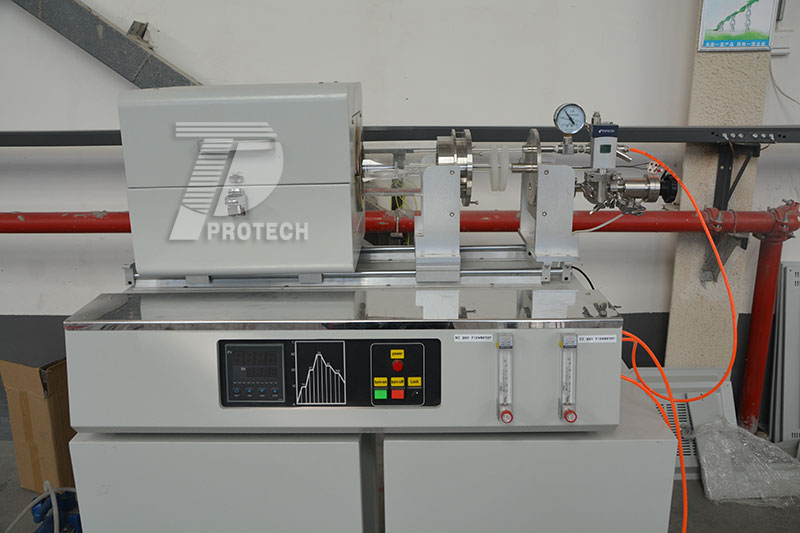


NEWS
The precautions for using the sliding RTP rapid annealing furnace cover multiple aspects such as preparation before operation, standardization during operation, maintenance after operation, and safety precautions. Let's take a detailed look below!

Customized atmosphere RTP fast annealing furnace (click on the image to view product details)
1. Preparation before operation
Equipment inspection
Confirm that the water level of the cooling system (such as a chiller) is normal and can circulate to avoid high temperature damage to the equipment.
Check the oil level of the vacuum maintenance system to ensure that the vacuum degree meets the standard (such as ≤ 10 ⁻ ³ Pa).
Verify whether the gas pressure (nitrogen, hydrogen, etc.) meets the requirements to avoid experimental failure or danger caused by abnormal gas pressure.
After the first use or long-term disuse, it is necessary to bake at 120 ℃ for 1 hour and 300 ℃ for 2 hours to prevent furnace cracking.
sample preparation
The sample should be placed in the center of the sample holder to ensure that the thermocouple wire is correctly inserted into the hole and avoid temperature sensing deviation.
Avoid overloading or overloading to prevent equipment from being overloaded and causing damage.
2. Standardized operation
Temperature rise control
Cold furnace start-up: The heating rate in the low-temperature section should not be too fast (such as ≤ 10 ℃/s) to avoid uneven heat absorption in the furnace and cracking.
High temperature limit: The furnace temperature shall not exceed the rated value (such as 3 minutes at 1000 ℃ and 60 seconds at 1200 ℃) to prevent damage to heating elements or furnace lining.
Program editing: Set the temperature rise, insulation, and cooling programs through software to ensure that the temperature curve meets the material requirements (such as nitrogen annealing at 400 ℃ for 5 minutes).
Vacuum and Atmosphere Control
After vacuuming to the target pressure (such as 0.01Pa), protective gases such as nitrogen and hydrogen are introduced according to process requirements.
When the vacuum degree decreases, check the sealing of the heat-resistant silicone ring or flange, and replace or reinstall it if necessary.
Cooling control
Sliding furnace body achieves rapid cooling: After the furnace is heated to the set temperature, it automatically moves to the sample area, and the cooling gas is directly blown onto the surface of the sample (such as automatically turning off the gas when rapidly cooling to 70 ℃).
Avoid pulling out the tray rack at high temperatures to prevent burns or equipment damage.
3. Post operation maintenance
Cleaning and maintenance
Do not pour liquids or dissolve metals into the furnace and keep the furnace clean.
Regularly clean dust and dirt to avoid affecting the annealing effect and equipment lifespan.
Component inspection
Regularly check whether the connection points of the heating element are tightened to prevent temperature fluctuations caused by poor contact.
Verify the accuracy of temperature measuring components such as thermocouples and pyrometers to ensure temperature control precision (e.g. ± 5 ℃).
Shutdown process
After the furnace temperature drops below 100 ℃, turn off the cooling device and vacuum system.
Close the gas valve and main power supply in order to avoid equipment damage caused by reverse process operation.
4. Safety precautions
high temperature protection
Do not open the furnace door when the furnace temperature is ≥ 300 ℃ to prevent burns or furnace cracking.
Wear protective gloves when taking and placing samples to avoid direct contact with high-temperature components.
Gas safety
When using flammable gases such as hydrogen, ensure the sealing of the gas path to prevent leakage and explosion.
When gas or cooling water alarm occurs, immediately stop operation and check the system.
Emergency treatment
When the program is interrupted and the chamber is at high temperature, manual cooling or editing of the cooling program is required before operation.
When encountering an unknown alarm, contact the administrator and do not handle it without authorization.
In general, when operating the sliding RTP rapid annealing furnace, it is necessary to strictly follow the user manual to prevent dangerous situations. If there is an uncertain alarm or result, it is recommended to check the nameplate behind the furnace and consult the technical personnel of the rapid annealing furnace to understand how to solve it. Do not blindly continue to heat up or try to solve it on your own!Click to learn more tube furnaces! Or click on online customer service to learn more about product information!
Leave A Message